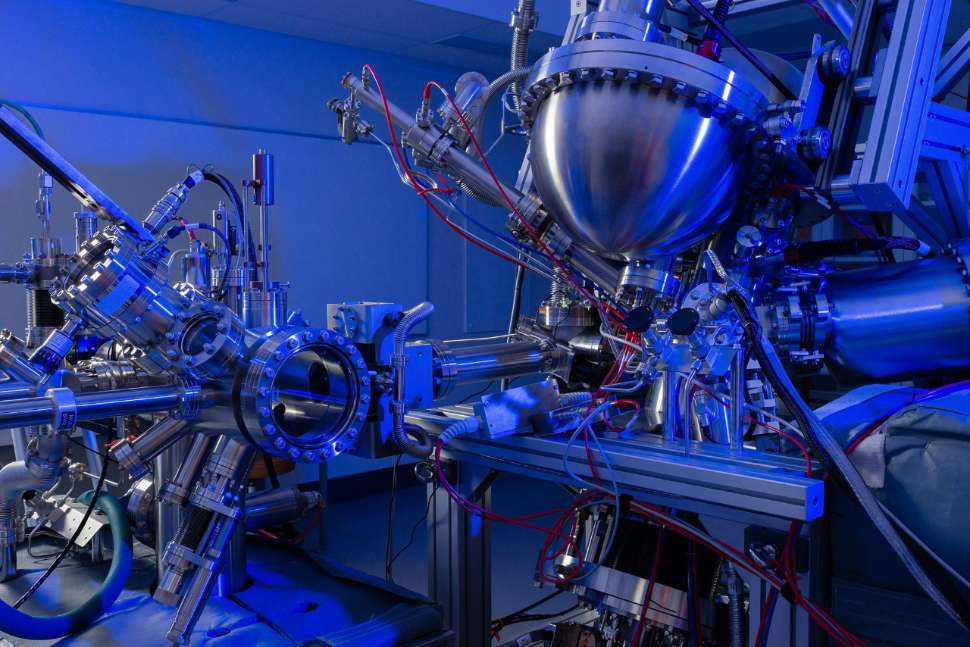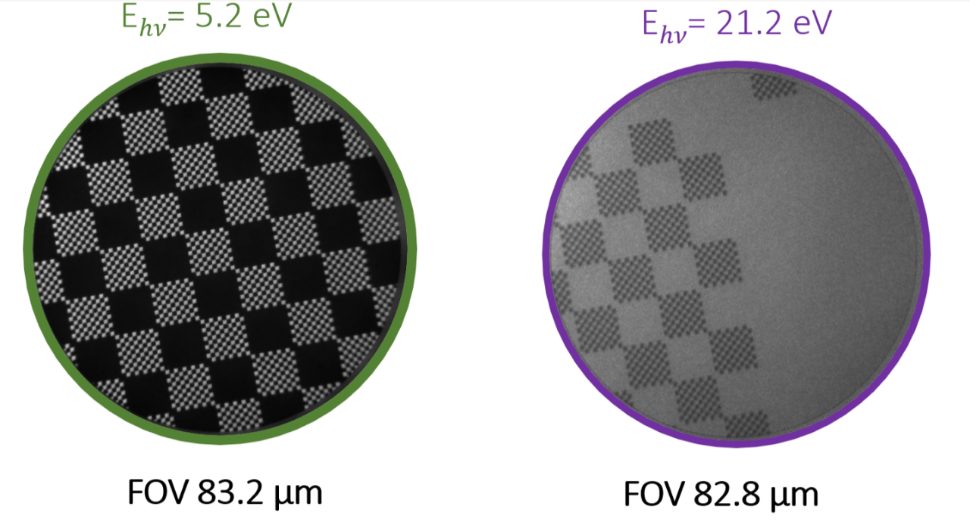Photoemission Electron Microscope (PEEM)
Photoemission occurs when an electron absorbs the energy of a photon (light) and is ejected out of the material. By employing electrostatic lenses, we can focus and detect these electrons to construct an image of the sample. The photoemission intensity depends on the physical and chemical structure of the material, enabling photoemission electron microscopy (PEEM) to image materials with chemical contrast (Figure 2.).
The photoemission process can also be used for chemical analysis through x-ray photoelectron spectroscopy (XPS) from localised regions on the sample and chemical mapping though x-ray PEEM (XPEEM).
By analysing the momentum of the electrons when they leave the material, we can map the band structure of materials (Figure 3). This is a form of angle-resolved photoelectron spectroscopy (ARPES).
All of these techniques are capable with our NanoESCA III, and they provide information about the physical characteristics and chemical composition of materials at nanometer scales.
Contact
Instrument Leader: Professor Sarah Harmer
PEEM Facility Manager: Dr Benjamin Chambers
NanoESCA III DOI: https://doi.org/10.25957/flinders.nanoesca3
VT-SPM DOI: https://doi.org/10.25957/flinders.vtspm.xa

Application examples

Fig2: PEEM images of a Au Grid on Si for different photon energies and electron energies

Fig 3: Band mapping of the Au(111) surface showing the 3D data cube, slicing along momentum directions and constant energy images.
Scienta Omicron NanoESCA III
Key instrument capabilities:
- PEEM energy-filtered imaging (<50nm lateral resolution)
- Small-spot XPS (FOV ~180μm)
- XPS imaging (XPEEM)
- ARPES
- Liquid helium cooled sample stage
- Sample temperatures in the range 20-400 K.
Here we have multiple light sources available:
- Hg (244-254 nm; 4.9-5.1eV)
- HeI (21.2eV) [HIS 14 HD VUV]
- HeII (40.8eV) [HIS 14 HD VUV]
- monochromated X-rays
- Al Kα (1486 eV) to probe the valance and core-level structure of materials.
Sample preparation module:
- Low-energy electron diffraction (LEED) - BDL600IR-LMX, OCI Vacuum Microengineering Inc.
- Sample cleaning through ion sputtering (Ion Source IS 40C1, PREVAC)
- Crystal cleaving in-vacuo
- Sample heating/cooling in manipulator (120-880 K)
PEEM is an ultrahigh vacuum technique. Samples are therefore limited to those that are non-outgassing. Samples for the PEEM are required to be conducting and flat over large areas. Some non-conducting materials may be investigated by applying a sub-nm thick metal coating to provide a conducting layer.
Typical applications for the technique include:
- Materials characterisation (Imaging, Chemical Analysis)
- Device characterisation (imaging and Band structure)
- Geoscience and Mineralogy (imaging, surface chemistry)
In person training to be completed with relevant staff, complemented by online modules instructional training videos and tests.
Our equipment is funded by:



![]()
Sturt Rd, Bedford Park
South Australia 5042
South Australia | Northern Territory
Global | Online
CRICOS Provider: 00114A TEQSA Provider ID: PRV12097 TEQSA category: Australian University








